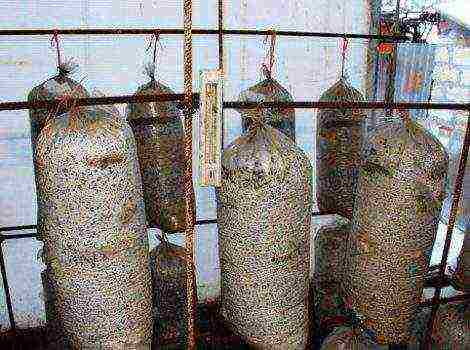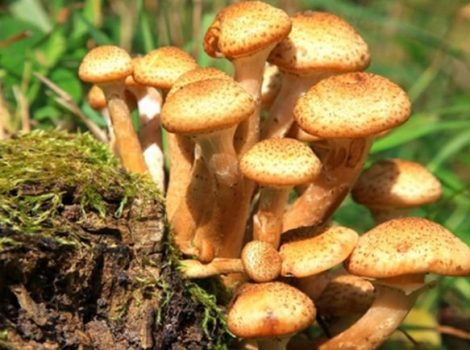Content
How to properly grow oyster mushrooms at home
The technology of growing and breeding oyster mushrooms at home with your own hands is quite simple, even an amateur can handle it. However, before you get down to business and grow mushrooms, you should familiarize yourself with the existing methods and requirements for the environment in which mushrooms will develop normally. Where to start and how to make the process from scratch, we will tell you step by step, and even a beginner will find it easy to breed and plant mushrooms.
Table of contents
- Conditions for growing oyster mushrooms at home
- Ways to grow mushrooms at home
- How to dissolve in bags with your own hands
- Step-by-step technology for breeding on stumps
- On substrate briquettes
- On racks
- How to make mycelium for oyster mushrooms
- Stages of growing mycelium
- Care of mushrooms during growth
- The profitability of growing at home
Conditions for growing oyster mushrooms at home
You can organize a place for the cultivation of mushrooms in basements, cellars or specially designed rooms at a summer cottage. For the cultivation of oyster mushrooms, you need to create the following conditions:
- the ability to set and maintain a temperature regime within 10-20 degrees;
- equip the room ventilation system for the removal of carbon dioxide and lamps with fluorescent lamps;
- set humidity mode 70-90%.
Due to their properties, mushrooms absorb elements of the environment, including toxins. Therefore, it is important that all surfaces in the basement are disinfected. free from mold and pests... It is necessary to maintain cleanliness until the very end of the harvest.
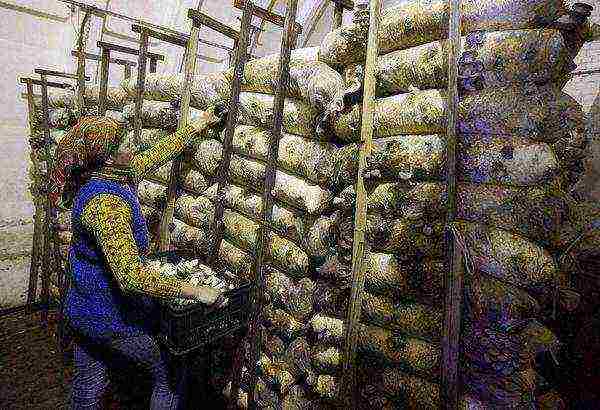
Ways to grow mushrooms at home
There are several ways to grow oyster mushrooms at home. Each method has advantages and disadvantages, so it is recommended that you familiarize yourself with all the intricacies of technologyto choose the one that suits you best.
How to dissolve in bags with your own hands
The substrate can be purchased ready-made or prepared with your own hands. The best raw material for oyster mushrooms is barley or wheat straw... Also suitable:
- hardwood shavings;
- buckwheat husk;
- sunflower husk;
- corn cobs and stalks.
The components used are necessary grind to 5-10 cm.
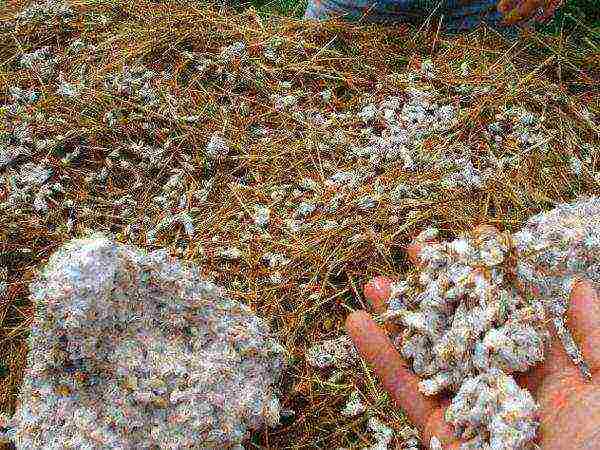
Those who are just starting to master the technology of growing mushrooms at home are advised to refrain from using sawdust. This method is complex and requires special requirements.
Before using the substrate, it is necessary to carry out disinfection material. For this, it is subjected to heat treatment.
Step-by-step procedure for disinfection of the substrate:
- the selected crushed raw material is poured into a metal tank or a spacious pan;
- fill the container with water (proportions 1: 2);
- bring the contents of the pan to a boil and cook for about 2-2.5 hours.
The finished base should be wet and soft, but do not overdo it with water. The correct composition releases the minimum amount of moisture during spinning.
In addition to the substrate, the seed (mycelium) is placed in the bag.It is not worth buying a lot at once, it quickly deteriorates. With proper care, from 1 kg of raw materials you can get up to 3 kg of oyster mushrooms.
The base is laid in the bags in layers, alternating the ball of the substrate with the seed. The bags are filled tightly without tamping. After tightly tying the edges of the container, cross-shaped holes are cut with a blade on the surface of the polyethylene. They need to be arranged at intervals of 10 cm in a checkerboard pattern.
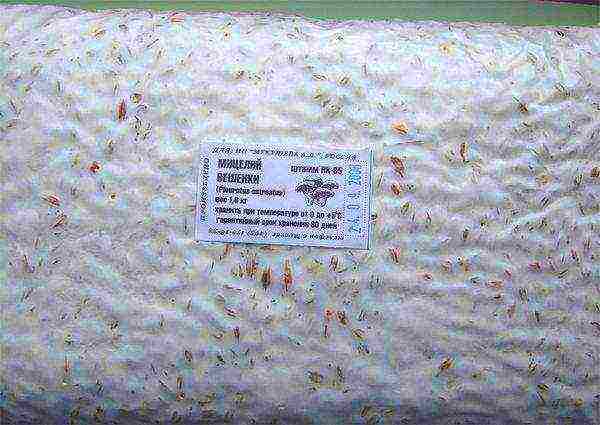
For 2 weeks, the bag is lowered into the basement for an incubation period at a temperature 19-23 degrees... Lighting is not required at this stage.
The main advantage of the method is the simplicity of the technology. However, there is often poor or no fruiting. In such cases, you need to sort out the substrate and check for mold.
Step-by-step technology for breeding on stumps
There are two main ways of growing oyster mushrooms: intensive and extensive. In the first case, special premises with favorable conditions. The second method is the technology of mushroom cultivation open air... The timing of the harvest depends entirely on weather conditions.
If there is neither a felling nor a cellar at the dacha, you should not be upset. You can grow oyster mushrooms directly on stumps or scraps of hardwood (chestnut, ash, poplar, beech, etc.).
Sowing dates begin in the spring in establishing positive temperatures. The cuttings are soaked for 1-2 days before use. This procedure is not performed with a fresh tree.
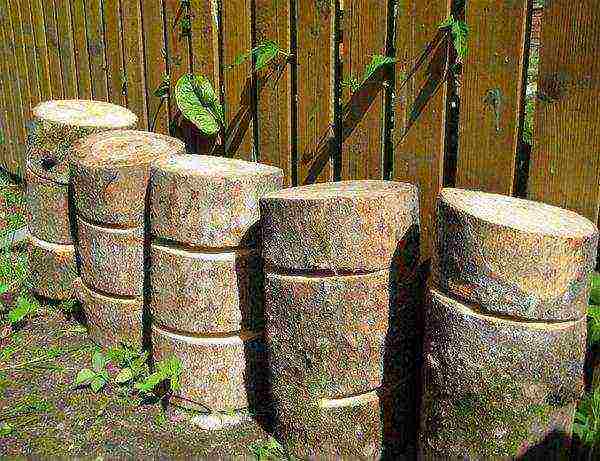
On the stumps, holes are pre-made with a diameter 10 mm with deepening on 5-6 cm... The seed is placed in the holes and covered with moss or adhesive tape. A stick-shaped mycelium is enough to insert into the hole and close it with plasticine.
The place for growing mushrooms is selected in the shadow under the dense crowns of trees. This is necessary to prevent the oyster mushrooms from drying out during the warm season.
When using logs, digging holes and laying wet sawdust on the bottom are provided. Further, soaked wood scraps are inserted into the prepared recesses and buried with soil for a third of the length (at least 15 cm). The spacing between stumps should be 35-50 cm.
Further care for the mushroom beds is to water the soil around the blanks. The collection time for oyster mushrooms more often falls on Aug. Sept... Such a plantation will bring good growth up to 5 years with the most generous fruiting 2-3 years after planting.
On substrate briquettes
Substrate briquettes are polyethylene sleevestuffed tightly with filler. Pre-applied on the surface of the film perforation round or other shape. The holes can be evenly spaced throughout the block or span only two sides.
In the first case, when fixing the briquettes, their contact must not be allowed, in contrast to double-sided perforation, where the junction has no holes.
The most popular are the capacities of the following parameters:
- weight - 15 kg;
- length - 70 cm;
- diameter - 25 cm.
There are many options for placing substrate briquettes. They can be suspended 2-3 pieces per rope or hang each one individually on the fittings. The weight of the bags is quite heavy, which provides stability when stacking blocks Each other... The result is a solid wall.
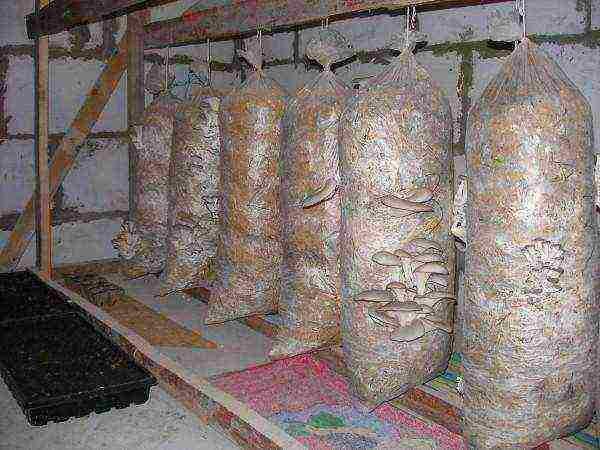
The arrangement of briquettes on the shelves is also allowed. in vertical or horizontal position. A rope stretched from the back of the shelves acts as a safety net against falling or falling of the substrate.When growing mushrooms at home, the decision on the placement of bags is made based on the characteristics of the room.
The advantages of the method:
- convenient application;
- easy care;
- getting a quick harvest (after 1.5-2 months).
The disadvantage is the additional costs for the purchase of substrate briquettes.
On racks
Briquettes or bags with substrate and seed in the basement or cellar can be placed on shelves if space permits. The shelves themselves must be made of wood or rolled steel. Blocks are placed vertically or horizontally.
Shelves are manufactured in various designs. Craftsmen independently develop drawings, providing safety elements that prevent the bags from falling. One of the options is equipped with special pins on the shelves, on top of which blocks are placed. Due to this, their stability is increased.
It is permissible to install mushroom sleeves in several tiers, but no more than three... In this case, the distance between the shelves should be 70 cm, and between mushroom bags - 15-40 cm.
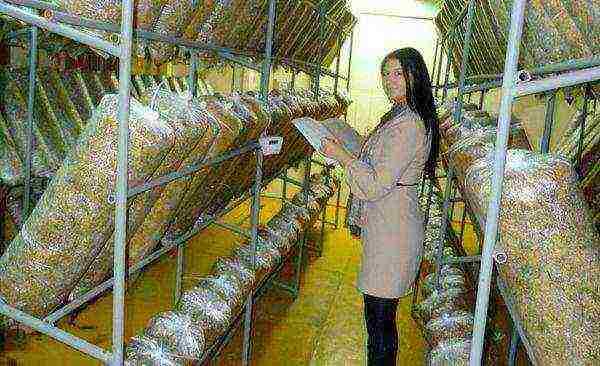
This method of growing oyster mushrooms is characterized by convenient maintenance and harvesting. However, not all summer cottages and cellars have a sufficient amount of space for installing shelving.
How to make mycelium for oyster mushrooms
It is not difficult to buy ready-made mycelium, but you can only evaluate the quality of your purchase after a few weeks. If a low-quality product is identified, it will no longer be possible to compensate for the costs of raw materials and energy resources, therefore many mushroom growers master the technology of mycelium production on their own.
The mycelium is planting material, which is introduced into the substrate to obtain a harvest of mushrooms.
At home, mycelium is grown mainly on wood or grain... The method with wood is appropriate to use with the subsequent replanting of mycelium on hemp. This seed has a long shelf life and disease resistance. The cereal appearance is obtained by applying the mother culture to a substrate of cereal grains.
A high quality mushroom is obtained in laboratory conditions... At home, this process can be repeated by preparing special equipment in advance:
- agar;
- thermometer;
- tweezers;
- test tubes;
- pipettes.
Also, work will require water, electricity, gas.
Stages of growing mycelium
- To obtain uterine mycelium, you need pinch off oyster mushrooms (from the area closer to the cap) a few small pieces. To cleanse the separated fragments from bacteria and parasites, it is recommended to dip them in hydrogen peroxide and dip the processed pieces into test tubes with crushed grains. Carrot, oatmeal, or potato agar can be used in place of the grain medium.
The tubes are tightly closed and stored in a room with an average humidity level and a temperature of about 20 degrees... After 2 weeks, a white edge will appear in properly prepared tubes. This is the uterine mycelium.
- To obtain an intermediate mycelium, you should boil cereal grains for 15 minutes. After cooling and drying, they are mixed with chalk and gypsum (for 1-1.5 kg of grains, take 30 grams of gypsum and 10 grams of chalk). The resulting mixture is poured into jars, filling it by 2/3. Then, uterine mycelium from a test tube is added to the container. The neck of the jar is closed with foil, which is fixed with tape. The workpiece is stored in the same conditions as the test tubes for 2-3 weeks... The result is a jar filled with grains and a fringe - an intermediate mycelium.
- The inoculum is obtained in the same way, by replacing the intermediate mycelium in clean containers with a substrate. After the growth of the mycelium, it is transferred into bags or briquettes with a substrate in which the mushrooms will be grown.
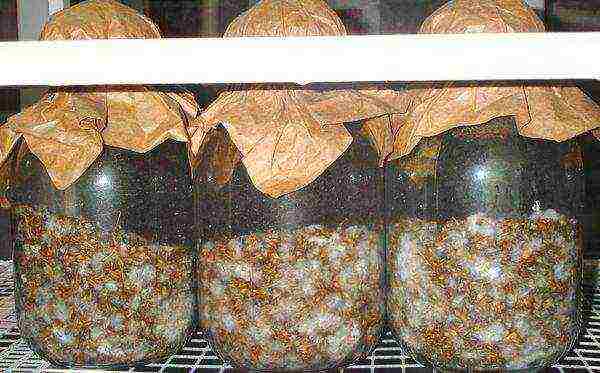
Care for mushrooms during growth
After replanting the mycelium in the holes of the polyethylene, the bags are sent to incubationwhich takes up to 3 weeks. The temperature regime should not reach 30 degrees, otherwise the planting material will undergo a heat shock.
At this stage no ventilation... The accumulation of carbon dioxide creates favorable conditions for the development of mycelium. All that is required is daily cleaning of surfaces using chlorine-containing products. This will help prevent mold growth.
Next, the bags are placed in a specially equipped room with a temperature 10-20 degrees... The cooler the air, the less saturated the color will be. Lighting should be 12 o'clock with an intensity of 5 kW per 1 m2. Every day 1-2 times, the mushrooms are watered with a special sprinkler.
In the room where mushrooms are cultivated, there is a high level of spores in the air, so work should be done with a mask and glasses. This will help prevent an allergy attack.
The profitability of growing at home
You can grow mushrooms in several briquettes, satisfying the needs of your family. But this type of activity, with a reasonable approach, sometimes becomes a means of additional income. Moreover, caring for mushroom beds is not considered difficult.
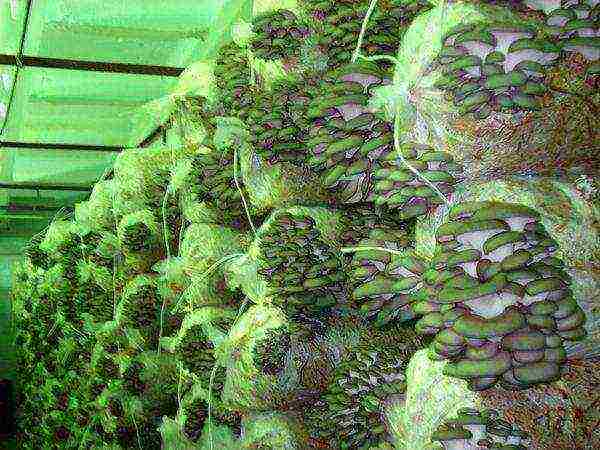
If you create optimal conditions for keeping mushroom briquettes (bags) and adhere to the established temperature regime, then 3-3.5 kg of mushrooms can actually be removed from one block. Respectively from 100 bags, 350 kg of oyster mushrooms are obtained.
Taking into account the market value (approximately 130 rubles per kg), the income will be 45,500 rubles. About half of the funds are spent on related costs associated with creating conditions for the cultivation of mushrooms. The net profit will amount to 20,485 rubles. The profitability in this case is 75%, payback - 5.2 cycles, which translated into months means 13-15 months.
The process of growing oyster mushrooms at home is quite exciting and educational. By accumulating experience, you can gradually increase the volume, which will allow you to turn your hobby into a small business.
